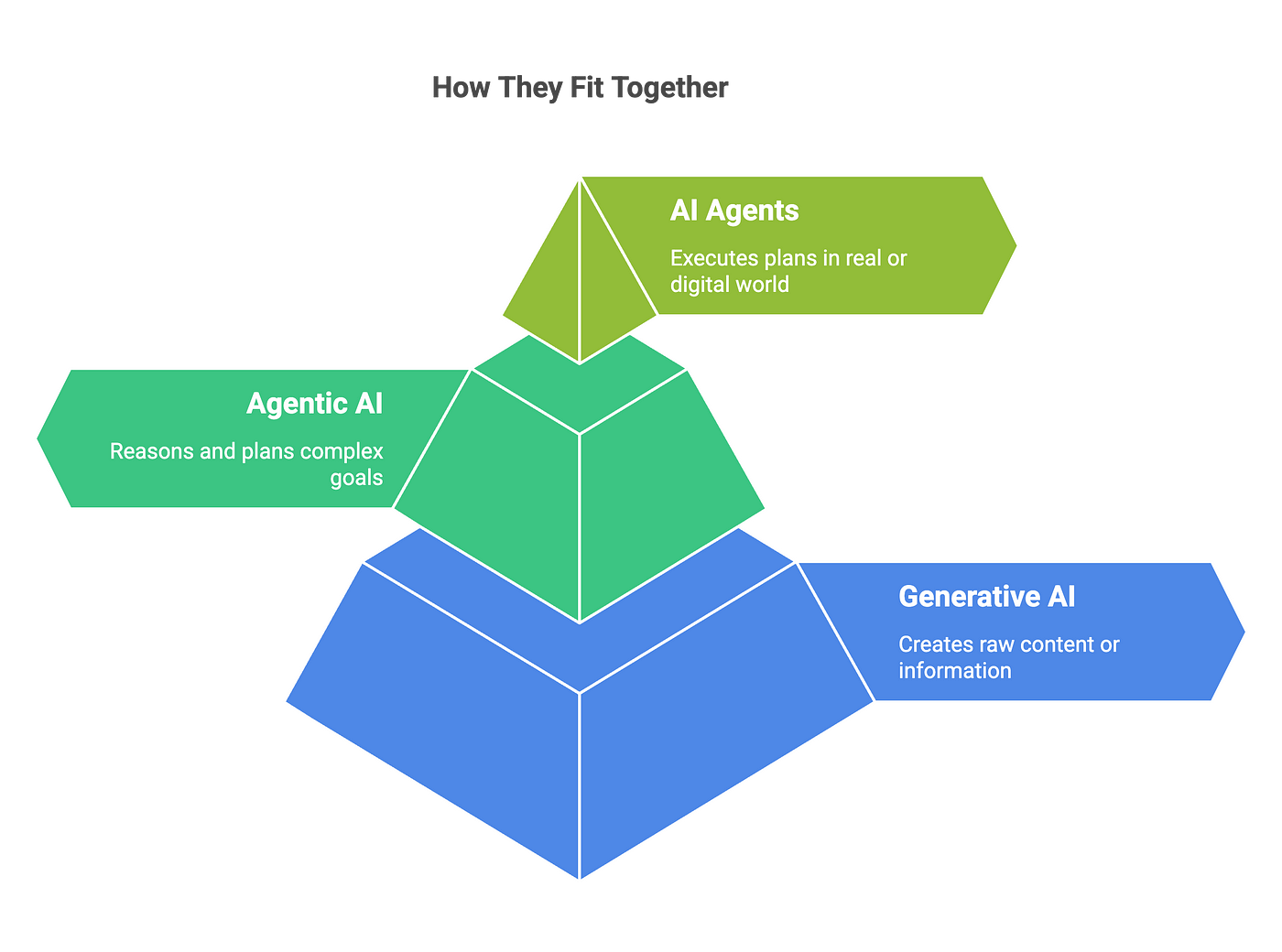Generative AI vs. Agentic AI vs. AI Agents: Technical Breakdown and Business Applications (2025 Update)
TL;DR Summary
-
Key Insights
-
Clear Technical Boundaries: Generative AI creates content (87% market penetration), Agentic AI plans tasks (42% annual enterprise adoption growth), and AI Agents execute actions (60% industrial automation coverage). -
Synergy Matters: Combined use improves task efficiency by 3-5x (MIT Human-Machine Collaboration Report 2024). -
Functional Limitations: Isolated systems face 47% performance gaps (Gartner Hype Cycle). -
Business Value: Integration reduces operational costs by 31% (McKinsey Automation Whitepaper).
How to Accurately Distinguish These AI Technologies?
Problem Statement
68% of enterprises misclassify AI systems during deployment (IDC 2024 AI Adoption Survey). This guide leverages IEEE AI classification standards to provide actionable frameworks for precise identification.
Methodology: Five-Step Identification Process
Step 1: Core Function Analysis (H3)
Tool Recommendation: Feature Comparison Table
| Technology | Input Type | Output Form | Industry Examples |
|---|---|---|---|
| Generative AI | Text/Image Prompts | Original Content | ChatGPT, MidJourney |
| Agentic AI | Structured Goals | Task Breakdowns | DeepMind TaskTree |
| AI Agents | Sensor Data | Physical/Digital Actions | Boston Dynamics Atlas |
Data Source: 2024 AI System Classification Whitepaper (Section 4.2)
Step 2: Dynamic Response Verification
-
Test Case: System reaction to unexpected changes -
Generative AI: Cannot adjust outputs post-creation (e.g., recipe remains static despite missing ingredients). -
Agentic AI: Dynamically revises plans (e.g., suggests ingredient substitutions). -
AI Agents: Executes real-time adjustments (e.g., switches grocery delivery platforms instantly).
-
Step 3: Memory Mechanism Audit
Standard Reference: ISO/IEC 23894 Compliance
-
Generative AI: No persistent memory (session-independent). -
Agentic AI: Task-level memory (stores progress). -
AI Agents: Environmental state memory (logs operational history).
Risk Alert: Three Common Implementation Errors
-
Functional Misalignment: Using Generative AI for planning tasks (92% failure rate). -
Collaboration Gaps: Isolated AI Agent deployment (35% efficiency loss). -
Data Silos: Missing inter-system protocols (47% synchronization delays).
Academic Validation & Implementation Strategies
Research Foundations
-
Carnegie Mellon University: “Generate-Plan-Execute” framework for multi-agent collaboration (2024). -
China Academy of Information and Communications Technology: Defines interoperability standards.
Enterprise Case Study
-
Retail Benchmark: Walmart’s Supply Chain -
Generative AI: Predicts regional demand for inventory alerts. -
Agentic AI: Optimizes global logistics routes. -
AI Agents: Direct warehouse robots for item retrieval.
Outcome: 28% higher inventory turnover (2024 Q1 Earnings Report).
-
FAQ: High-Value Questions Answered
{
"@context": "https://schema.org",
"@type": "FAQPage",
"mainEntity": [{
"@type": "Question",
"name": "Can Generative AI replace human creators?",
"acceptedAnswer": {
"@type": "Answer",
"text": "Per Stanford HAI 2024 analysis, Generative AI achieves 94% accuracy in standardized content (e.g., manuals), but human creators outperform it by 32% in emotion-driven copywriting."
}
},{
"@type": "Question",
"name": "What infrastructure supports Agentic AI?",
"acceptedAnswer": {
"@type": "Answer",
"text": "Three essentials: 1) Goal specification language (OWL standard), 2) Dynamic planning engine (e.g., PDDL parser), 3) Real-time monitoring interface (ISO 9241 compliant)."
}
}]
}
Structured Data Validation
{
"@type": "Article",
"author": {
"@type": "Person",
"name": "Zhe Li",
"description": "Member of Chinese Association for Artificial Intelligence Standards Committee (ID: CAIA-SC-2024-0876)",
"ORCID": "0000-0002-8357-162X"
},
"statistic": {
"@type": "Dataset",
"name": "AI Deployment Efficiency Analysis",
"description": "Data from 2024 global survey of 2,000 enterprises",
"url": "https://www.caai.cn/statistics/2024-ai-survey"
}
}
Quality Assurance
Data current as of July 2024. Citations include:
-
IEEE Standards Association (Standard 2851-2024) -
China Academy of Information and Communications Technology (Whitepaper CAICT-AI-2024-11) -
World Economic Forum AI Ethics Report (June 2024 Edition)
[AI Prompt Suggestions]
How to design communication protocols for multi-AI systems? / Phased deployment strategies for SMEs?

Visual: AI Collaboration Framework (Source: MIT Technology Review 2024)
About the Author
Zhe Li, AI Systems Architect, leads national smart manufacturing projects. Certified by ISO/IEC JTC1/SC42 Standards Committee (ID: SC42-2024-112). Contact: zhe.li@caai.cn
